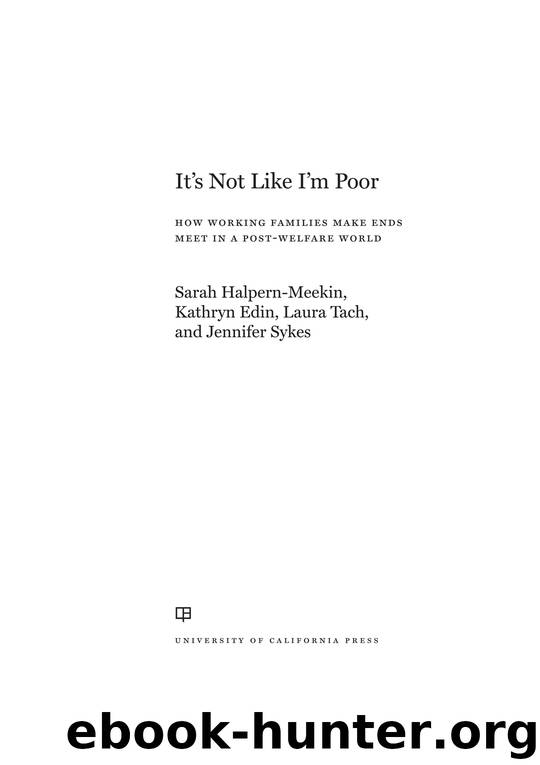It's Not Like I'm Poor by Sarah Halpern-Meekin

Author:Sarah Halpern-Meekin
Language: eng
Format: epub
ISBN: 9780520275348
Publisher: University of California Press
CREDIT
Credit can play the vital function of enabling households to smooth consumption in the face of a financial shock or to invest in a purchase now that may pay off in the future (like a car to access a better-paying job in the suburbs, or a stand-alone freezer, enabling bulk purchases of meat and other frozen goods). Credit also offers vital assistance to families making large onetime or seasonal purchases, such as household furnishings, a washing machine or refrigerator, or back-to-school clothes, because payments for such big-ticket items can be spread out over time. However, as we show in the next chapter, credit can be a double-edged sword.16
Credit raises the risk of accumulating debt. Yet families generally know that they need to establish and use credit in order to increase that all-important credit score. Credit is most risky for families who face income fluctuations throughout the year—access to credit might keep the lights on or stock the pantry, but if one’s financial boat doesn’t right itself in a month or two, it can become hard to pay off the balance or keep up with the monthly payments. And missed credit card payments may bar families from accessing larger, and arguably more important, lines of credit for car or home purchases in the future. In addition, employers now routinely access credit reports when assessing the credentials of job seekers.17 Indeed, those with poor credit scores can have difficulty finding a private landlord—at least one with a desirable unit—who is willing to rent to them; this can relegate them to the bottom of the housing market (public housing, or units in violence-ridden neighborhoods with poor-quality schools).18
This is not to say that lower-income families are ignorant of the importance of credit, and credit scores, in meeting their asset goals. Shari Barfield, the realtor, and her husband have three credit cards, two of which have zero balances. They reserve these cards for emergencies, but the third has a balance of $500 and a credit limit of $3,000. Shari describes their approach to finances as follows: when it comes to deciding which bills to pay first, they prioritize paying whichever are the highest (to keep balances from getting too unwieldy) as well as the credit cards “because you have to pay your credit cards down to keep your credit maintained.” The Barfields are among the asset elites in our study, with $12,000 between Shari’s checking and savings accounts (and some extra in her husband’s account), two paid-off cars, and $4,300 available on their credit cards.
As the narratives we’ve related above show, standard strategies to build assets are of limited utility among many of the families with whom we spoke. Nonetheless, dreams of a brighter financial future and a better quality of life do animate financial behavior to some degree, especially for those with higher and more stable incomes. And the dreams may be of substantial value themselves. They may offer hope and enhance low-earning households’ sense that they are part of the American mainstream.19
Download
This site does not store any files on its server. We only index and link to content provided by other sites. Please contact the content providers to delete copyright contents if any and email us, we'll remove relevant links or contents immediately.
Harry Potter and the Goblet Of Fire by J.K. Rowling(3025)
Never by Ken Follett(2873)
Shadow of Night by Deborah Harkness(2710)
Ogilvy on Advertising by David Ogilvy(2677)
Zero to IPO: Over $1 Trillion of Actionable Advice from the World's Most Successful Entrepreneurs by Frederic Kerrest(2375)
The Man Who Died Twice by Richard Osman(2290)
Machine Learning at Scale with H2O by Gregory Keys | David Whiting(2267)
Book of Life by Deborah Harkness(2259)
How Proust Can Change Your Life by Alain De Botton(2256)
My Brilliant Friend by Elena Ferrante(2218)
0041152001443424520 .pdf by Unknown(2214)
The Tipping Point by Malcolm Gladwell(2200)
How to Pay Zero Taxes, 2018 by Jeff A. Schnepper(2095)
Will by Will Smith(2033)
Purple Hibiscus by Chimamanda Ngozi Adichie(1978)
Hooked: A Dark, Contemporary Romance (Never After Series) by Emily McIntire(1932)
Borders by unknow(1779)
Rationality by Steven Pinker(1761)
Daughter of Smoke and Bone by Laini Taylor(1737)
